|
|

 |
 P 8 W 3 D 2
L 3 F 16:A 11 P 8 W 3 D 2
L 3 F 16:A 11
50% successful

|
|
Description |
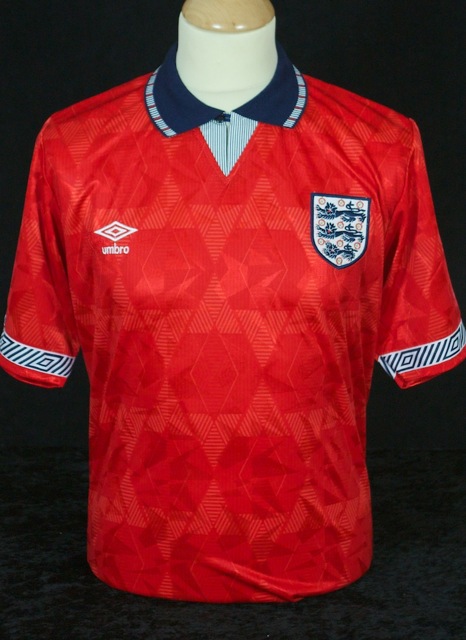 |
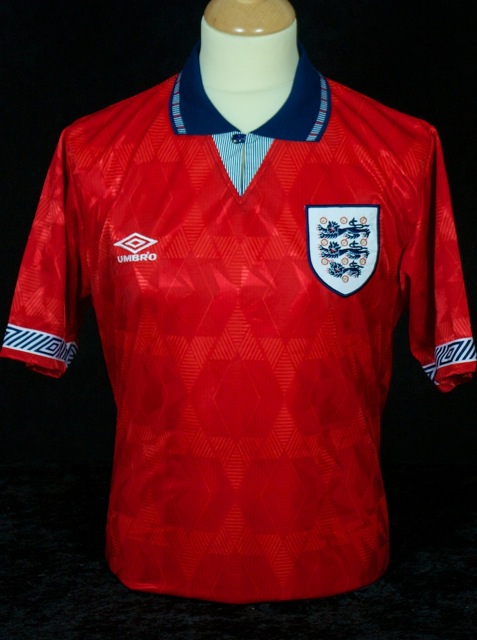 |
 |
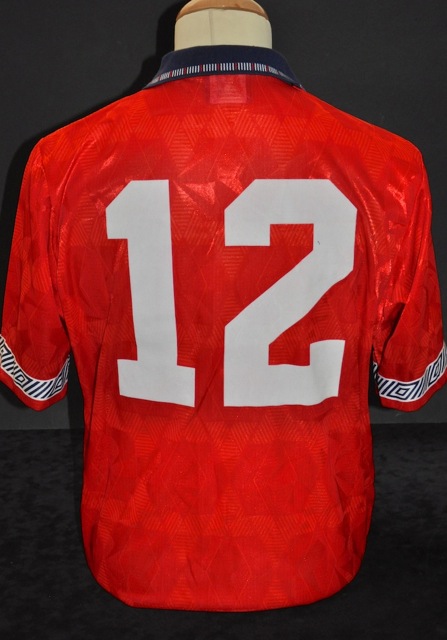 |
|
Red short-sleeved shirt, with
a dual-layered shadow pattern. One layer includes rows of large interlocking diamonds, the top and bottom of which consist of triangles, each
split into three separately-striped compartments. Two of the
compartments are triangular, one on each side of the diamond, with
diagonal stripes rising from right to left at the top left and bottom
right of the diamond, and from left to right at the top right and bottom
left of the diamond. A smaller horizontally-striped diamond is the third
compartment and sits at the upper and lower points of the large diamond,
which also includes a second concentric diamond within. Another layer of
geometric shapes is overlaid. Navy-blue winged collar, with small white stripes in a strip near
the outer edge, and a red stripe after every fifth white stripe. Large white upside-down triangular insert beneath the
neck,
with thin navy-blue stripes, split down the middle, with a navy-blue button
fastening via a loop of navy-blue material attached to the left side of
the insert. Navy-blue diagonal stripes rising from left to right in a
white strip near the edge of the sleeves, with two navy-blue concentric
diamonds after every fourth stripe. Embroidered emblem on left breast.
Two embroidered white concentric diamonds on right breast, with 'umbro' in
white
lower-case lettering underneath. White numbers on back, in the same
font as on the previous Umbro England shirts, with a red border, outlined in
white.
White shorts, with white
drawstring. A strip of navy-blue diagonal stripes rising from right to
left, comprising upper third of seams, with two navy-blue concentric
diamonds after every fourth stripe. A large red triangle, and below
that, a large navy-blue triangle, each with its base running down
middle of seam, underneath navy-blue stripes. Two
embroidered navy-blue concentric diamonds on left thigh, with 'umbro' in
navy blue
lower-case lettering underneath. Embroidered emblem on right thigh.
Red socks, with
white turnover, three navy-blue lions on each. |
|
Variations |
- A
second version of the shirt was
prepared for the 1990 World Cup in Italy, but was never worn in a full
international. 'FIFA WORLD CUP ITALY '90' was displayed in
white directly
underneath the emblem.
- A third version of
the shirt was prepared for the 1992 European Championship in Sweden, but was
never worn in a full international. 'EURO 92 SWEDEN' was displayed in white
directly underneath the emblem. The number was in the middle of
the chest in white, in the same font as on the back of the shirt, with a
red border, outlined in white, and the player's surname was above the
number on the back, in plain white (pink characters were unused).
.jpg)
- On the European
Championship kit and for the games played in 1993, the lettering
underneath the concentric diamonds logo on both the shirts and shorts, was
capitalised i.e. 'UMBRO'. There was also a registered trademark i.e.
®
placed above the gap
between the 'R' and the 'O' in white.
- A fourth version of
the shirt was introduced for the US Cup games in 1993. The emblem was
changed to accommodate a white margin around it (as per the 1993 white
shirt), the number on the back was changed to a plain white font (the
same as
the one used on the new white shirt) and the player's surname was worn above the number in
capitalised plain
white lettering, but in a different font to that worn in the previous year's European
Championship (pink characters were unused).
.jpg)
- Below is a direct comparison of the two name (and number)
fonts: on the left, the unused red Euro '92 shirt, and on the right, the red
US Cup shirt.
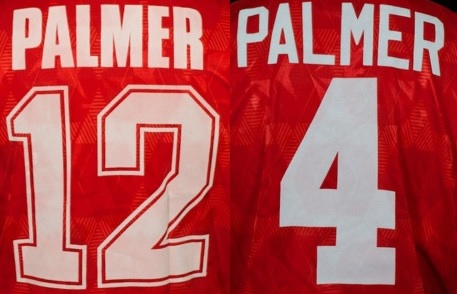
- For the kit's
last appearance, against San Marino, the shirt was the same as for the US
Cup games, apart from the absence of a name on the back. Thus, it became
the fifth version of the shirt (although only three were worn in full
internationals).
- For the games against
Australia and Malaysia in 1991 (when England wore all-white kits), and for the two games played in 1992, the right seam of
the shorts switched the relative positions of the red and navy-blue
triangles, with the blue being above the red for some players (not all). The left seams
mostly remained with
the red triangle above the blue, but clearly an inconsistency had crept in
to the issuing of the match shorts.
- For the games in
1993, the blue triangle was above the red triangle on both seams of the
shorts and the emblem was changed to accommodate a white margin around it.
- Against Germany in
1993, on the right thigh of the shorts, to the left of the emblem, England
wore red numbers in the same font as on the back of the shirt. The same font
would also have been used on the right thigh of the shorts for the 1992
European Championship finals, but they were never worn.
|
|
Most Appearances |
8 - Des Walker (1 sub)
6 - Stuart Pearce (1 sub),
David Platt
-
Walker, who had worn
the 1990 white shirt the most, appeared in all eight games; starting seven and coming
off the bench against the United States in the US Cup.
-
He also won his 59th
and last cap, against San Marino, on the last occasion that the shirt was
won.
-
Four players made their international
debuts in the shirt. Earl Barrett also won his third and last cap in the
shirt, with Brian Deane also winning two more caps.
-
Eight players won their last caps in the
shirt, including Gary Stevens, for whom it was his 46th
international appearance.
|
|
Top Scorers |
5 - David
Platt
4 - Ian Wright
2 - Paul Ince, Gary
Lineker
|
|
Captains |
4 - Gary
Lineker
1 - Paul Ince, Stuart Pearce,
David Platt, Bryan Robson
|
|
|

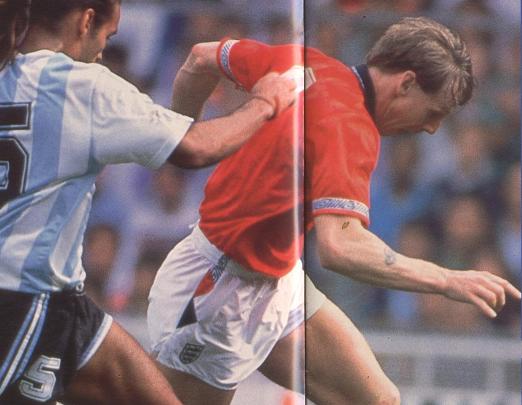 This red shirt could be forgiven for having an
identity crisis, for even though it only made eight appearances in three and a
half years, there were five different versions produced. This red shirt could be forgiven for having an
identity crisis, for even though it only made eight appearances in three and a
half years, there were five different versions produced.
It was launched in 1990 as the
second-choice kit for the World Cup in Italy, but it was worn first in a
pre-tournament friendly against Uruguay at Wembley. The World Cup shirt was
not required as England wore their new white uniform in every game of their
glorious run to the semi-finals, where they won the toss, forcing West
Germany to wear their green change shirts.
The original kit was only
worn twice more, in 1991, whilst subtle changes were already being introduced.
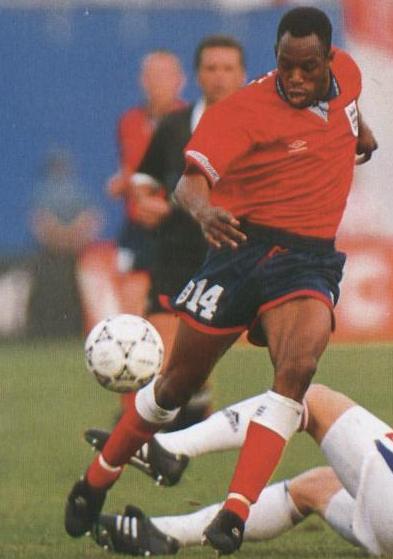 For
some strange reason, the shorts underwent a design change. Someone decided to
switch the positions of the red and blue triangles on the seam. Not on both
seams, just the right seam. We had an advance preview of this when England wore
all For
some strange reason, the shorts underwent a design change. Someone decided to
switch the positions of the red and blue triangles on the seam. Not on both
seams, just the right seam. We had an advance preview of this when England wore
all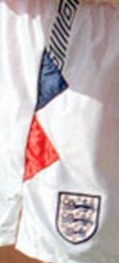 white in Australia, incorporating this new white pair with the home shirt
and socks. By the
following year, this same changed design had become part of the red uniform.
white in Australia, incorporating this new white pair with the home shirt
and socks. By the
following year, this same changed design had become part of the red uniform.
In 1992, Umbro updated their logo to use an upper-case version of
their name, together with a subtle trademark, but this change was not present on
the red kit worn against Brazil and Finland in the warm-up games for the
European Championship. It did, however, appear on the kit earmarked
as a second choice for the tournament in Sweden. Unfortunately, like its World Cup
predecessor, it never saw the light of day.
1993 gave us an overhaul of the red
shirt. As the
new white shirt had changed the font of the number on the
back and included a
re-designed emblem with a surrounding white margin, the red was obliged to
follow suit. For the US Cup, we also had surnames on the back (for the first
time on a red shirt) and a number on the shorts. Then, just to keep me on my
toes, they changed the design of the shorts again. This time the triangles were
consistent on both seams, with the blue completing its transition to being above
the red. Unfortunately, for the kit's last appearance,
however, against San Marino, they went back to the
1991 shorts design, with the red triangles uppermost,
and only on the left seams. suit. For the US Cup, we also had surnames on the back (for the first
time on a red shirt) and a number on the shorts. Then, just to keep me on my
toes, they changed the design of the shorts again. This time the triangles were
consistent on both seams, with the blue completing its transition to being above
the red. Unfortunately, for the kit's last appearance,
however, against San Marino, they went back to the
1991 shorts design, with the red triangles uppermost,
and only on the left seams.
-
The shirt was also
worn with the 1993 home blue shorts when England won the 1993 European Under-18
Championship at the City Ground, Nottingham, with a 1-0 victory against Turkey.
The kit was identical to that worn by the full squad, except that the emblem
included a scroll underneath, which contained the word 'YOUTH'.
The
shirts at the top of the page are (from left to right); Carlton Palmer's
against Finland in 1992, Tony Dorigo's in the US Cup in 1993, the
reverse of Carlton Palmer's shirt from the US Cup and the reverse of
Palmer's shirt against San Marino in 1993. All four shirts appear by kind permission of the
Neville Evans National Football Shirt Collection (curator Simon Shakeshaft).
|
|
Matches in which England wore the
1990 Away Red Uniform |
|
672 |
25 May 1991 -
England 2
Argentina 2 [1-0]
Wembley Stadium, Wembley, London (44,497) |
Lineker, Platt
García, Franco |
HD |
|
Friendly matches |
|
674 |
3 June 1991 -
New Zealand 0
England 1 [0-0]
Mount Smart Stadium, Penrose, Auckland
(17,520) |
Lineker |
AW |
|
England
wore the red away shirts and socks with the 1990 blue home
shorts, against New Zealand. |
|
U.S. Cup |
|
697 |
9 June 1993 -
United States 2 England 0
[1-0]
Foxboro Stadium, Boston, Massachusetts (37,652) |
Dooley, Lalas |
AL |
|
England
wore the red away shirts and socks with the 1990 blue home
shorts, against United States. |
|
699 |
19 June 1993 -
Germany 2 England 1
[1-1]
Pontiac Silverdome, Pontiac, Michigan (62,126) |
Effenberg, Klinsmann
Platt |
NL |
|
Other matches in which England wore the
1990 White Shorts |
|
673 |
1 June 1991 -
Australia 0 England 1
[0-1]
Sydney
Football Stadium, Moore Park, Sydney (35,472) |
Gray OG |
AW |
|
England
wore all white, the 1990 white home shirt and socks with the white away
shorts, against Australia. |
|
676 |
12 June 1991 -
Malaysia 2 England 4
[0-3]
Stadium
Merdeka, Wilayah Persekutuan, Kuala Lumpur (41,248) |
Marjan (2)
Lineker (4) |
AW |
|
England
wore all white, the 1990 white home shirt and socks with the white away
shorts, against Malaysia. |
The Youth teams (Under-19s and
below) wore the same design, except that each wore an embroidered scroll below
the emblem, within which YOUTH was displayed, in white. England's Under-21
team wore an identical kit to the full international team. When the Under-19s
played in Australia in the World Youth Championship in 1993, each player's
surname was worn in white on the back of the shirt above the number, in the
same font as was to be used in the US Cup (Steve Watson also wore his first
initial i.e. S. WATSON to distinguish him from goalkeeper, David Watson,
whilst Chris Bart-Williams wore WILLIAMS on his back). They
wore navy-blue (not red) numbers on the right thigh of the shorts, to the left of the emblem,
in the same font as on the back of the shirts (the newer 1993 font), and most
players wore long-sleeved shirts, with the same pattern of navy-blue diagonal
stripes and concentric diamonds near the cuffs as on the short sleeves.
Instead of the 'YOUTH' scroll, the
following was displayed below the emblem on the left breast (not actual font):
WORLD YOUTH CHAMPIONSHIPS
AUSTRALIA 1993
|
It was also worn on the bench by
unused substitutes, Gary Charles, Andy Cole and Teddy Sheringham.
|
England's Record wearing the 1990 Away
Shirt |
|
Type |
P |
W |
D |
L |
F |
A |
GD |
FTS
|
CS |
FAv |
AAv |
Pts % |
W/L |
|
Home |
3 |
0 |
2 |
1 |
5 |
5 |
=0 |
0 |
0 |
1.667 |
1.667 |
33.3 |
-1 |
|
Away |
4 |
3 |
0 |
1 |
10 |
4 |
+6 |
1 |
1 |
2.50 |
1.00 |
75.0 |
+2 |
|
Neutral |
1 |
0 |
0 |
1 |
1 |
2 |
-1 |
0 |
0 |
1.00 |
2.00 |
00.0 |
-1 |
|
Total |
8 |
3 |
2 |
3 |
16 |
11 |
+5 |
1 |
1 |
2.00 |
1.375 |
50.0 |
=0 |
____________________
CG/GI/PY
|
|


 P 8 W 3 D 2
L 3 F 16:A 11
P 8 W 3 D 2
L 3 F 16:A 11




.jpg)
.jpg)


 This red shirt could be forgiven for having an
identity crisis, for even though it only made eight appearances in three and a
half years, there were five different versions produced.
This red shirt could be forgiven for having an
identity crisis, for even though it only made eight appearances in three and a
half years, there were five different versions produced.

 suit. For the US Cup, we also had surnames on the
suit. For the US Cup, we also had surnames on the